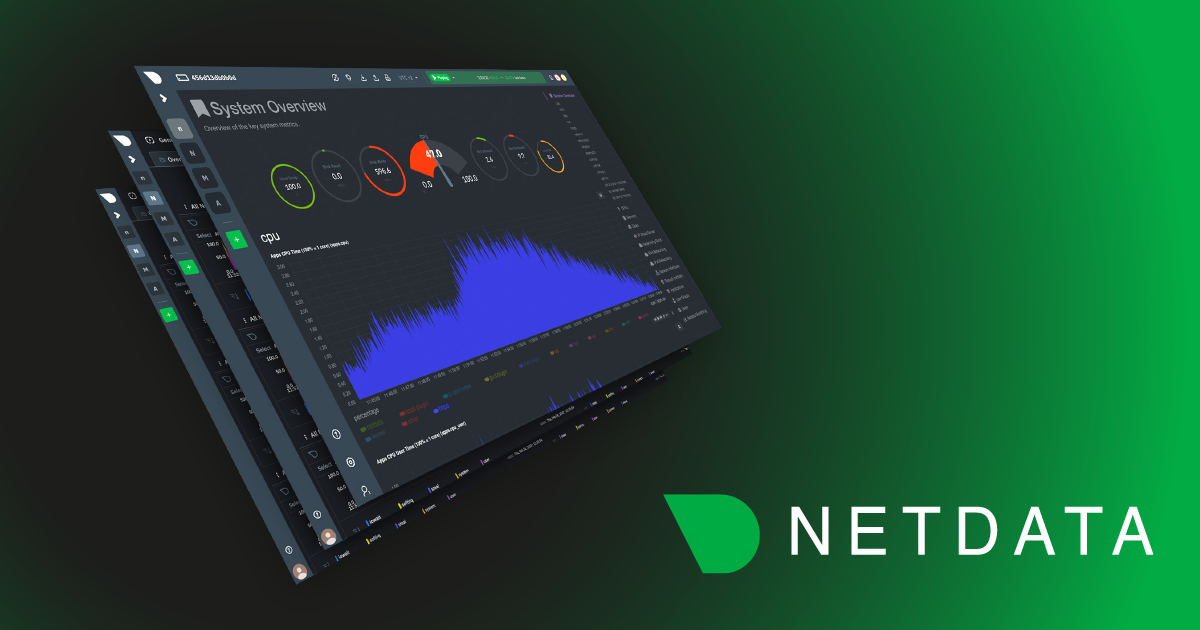So, you think you monitor your infra?
23 posts tagged with "infrastructure-monitoring"
View All TagsWhy Scalable Monitoring is Essential for Modern, Distributed Systems

It's becoming increasingly common to discuss the importance of scalability in monitoring solutions and how it can impact the performance and reliability of distributed systems.
Monitoring remote UNIX-like systems using Netdata and Net-SNMP

Need to monitor a UNIX-like system, but can’t install Netdata on it? With our SNMP collector and Net-SNMP, you can get basic system information with just a bit of relatively quick and easy configuration.
Introducing the Netdata demo space

Introducing Netdata's Demo Space, a quick and easy way to experience monitoring environments before you set them up yourself.
Google Colab Monitoring with Netdata

Hello, fellow data enthusiasts and Google Colab aficionados! Today, we're going to explore how to monitor your Google Colab instances using Netdata. Colab is a fantastic platform for running Notebooks, developing ML models, and other data science and analytics tasks. But have you ever wondered how your Colab instance is performing under the hood? That's where Netdata comes into play!
How to monitor and troubleshoot NGINXPlus
How to monitor node reboots?
Monitoring the health and status of nodes and servers is a critical part of effective infrastructure monitoring.

How to monitor NVMe metrics servers?
Use Netdata to effectively monitor and troubleshoot the performance of NVMe (Non-Volatile Memory express) disks in your infrastructure. Preempt disk failures and take action to ensure your systems run without a glitch.

How to monitor NGINX web servers?
Web servers are among the most important components in modern IT infrastructures. They host the websites, web services, and web applications that we use on a daily basis. Social networking, media streaming, software as a service (SaaS), and other activities wouldn’t be possible without the use of web servers. And with the advent of cloud computing and the movement of more services online, web servers and their monitoring are only becoming more important. Given the extensive usage of Web servers, Sysadmins and SREs should monitor web servers as a key aspect for performance.

Monitoring & troubleshooting Cassandra with Netdata
How to monitor and troubleshoot Cassandra with Netdata.

How to monitor and fix Database bloats in PostgreSQL?
Database bloat is disk space that was used by a table or index and is available for reuse by the database but has not been reclaimed. Bloat is created when deleting or updating tables and indexes. Here's how to deal with it!
Cassandra monitoring
What are the important Cassandra metrics to monitor and how to monitor them.
How to find out which application is causing server load
We often hear the term load used to describe the state of a server or a device, but we're here to tell you what it means, precisely, and how to monitor it.
How to monitor the disk usage on your infrastructure
The most important part of disk usage monitoring is to check the utilization of each filesystem and each mount point which can reveal existing or impending issues with the storage space on your infrastructure.
7 types of Redis latency and how to fix it
Redis is designed to be fast. In most cases, it is. However, there are times when Redis may be slow, due to network issues, disk latency, or other factors. When this happens, it is important to be able to detect the slow down and investigate the cause of Redis latency.
How to monitor systemd service liveness
The life of a sysadmin or SRE is often difficult, but occasionally very simple things can make a huge difference. Basic monitoring of your systemd services is one of those simple things, which we sometimes overlook. The simplest question one would want to know is if the thing that’s supposed to be running is actually running at all. If you use systemd services, you can guarantee an answer to that question within minutes using Netdata.
How to monitor web servers and their performance
How to monitor HTTP endpoints
The HTTP protocol has become the de facto standard application layer protocol of the internet. From publicly available web sites and APIs to “inter-process” communications in REST based microservice architectures or large Service Oriented Architectures based on SOAP, you find HTTP being used again and again, due to its simplicity and our familiarity with it. How many protocols can you name that have memes for their status codes? Of course, such a popular protocol has endless pages written about how to properly monitor the services that rely on it, with many options specific to every use case.
How to monitor DNS query response time
DNS (Domain Name System) servers translate standard language web addresses to their actual IP addresses for network access.
Why is data replication important?
High availability. This is what every monitoring tool needs to ensure that you never compromise on IT infrastructure visibility.
Data Collection Strategies for Infrastructure Monitoring – Troubleshooting Specifics
Monitoring without Cooperation: Kubernetes
Kubernetes Throttling Doesn’t Have To Suck. Let Us Help!
CPU limits are probably the most misunderstood concept in Kubernetes CPU resources allocation and management.



